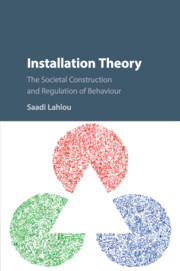Book contents
- Installation Theory
- Installation Theory
- Copyright page
- Dedication
- Contents
- Figures
- Plates
- Foreword
- Acknowledgements
- Introduction
- Chapter 1 Installation
- Chapter 2 The Problem of Human Action and the Problem of Social Regulation
- Chapter 3 Theoretical Frameworks Grounding Installation Theory
- Chapter 4 The Structure of Installations
- Chapter 5 Endurance of Installations
- Chapter 6 Selection Mechanisms in Societal Evolution
- Chapter 7 The Evolution of Installations
- Chapter 8 Redesigning Installations to Change Behaviour
- Chapter 9 Conclusion
- Glossary
- References
- Index
Chapter 5 - Endurance of Installations
The Reconstructive Cycle of Practice
Published online by Cambridge University Press: 28 December 2017
- Installation Theory
- Installation Theory
- Copyright page
- Dedication
- Contents
- Figures
- Plates
- Foreword
- Acknowledgements
- Introduction
- Chapter 1 Installation
- Chapter 2 The Problem of Human Action and the Problem of Social Regulation
- Chapter 3 Theoretical Frameworks Grounding Installation Theory
- Chapter 4 The Structure of Installations
- Chapter 5 Endurance of Installations
- Chapter 6 Selection Mechanisms in Societal Evolution
- Chapter 7 The Evolution of Installations
- Chapter 8 Redesigning Installations to Change Behaviour
- Chapter 9 Conclusion
- Glossary
- References
- Index
Summary
This chapter is where the installation framework turns into a theory. It describes how installations are reconstructed through practice. In doing so, it addresses the first aspect of evolution: endurance (the second aspect is change, which is considered in Chapters 6 and 7).
This chapter starts with a sketch of the general cyclical process by which installations produce practice, and practice produces installations (Section 5.1).
In the three subsequent sections (5.2, 5.3 and 5.4) we examine the reproduction of each layer, starting with embodied competence. The layers are not addressed here in their usual order; the embodied layer is described first because of its key role in the reconstruction process.
Installations are resilient as a result of some redundancy of their three layers. This redundancy enables them to induce even incompetent (e.g. novice) subjects to behave appropriately. In doing so, participants learn in doing. The embodied layer is therefore reproduced by the two others. Learning processes at relational level (by legitimate peripheral participation, intent community participation, instruction, education or trial and error) are described, as are feedback and embodiment processes that account for the inscription of competences at the neuronal level. This concept is illustrated in Section 5.2 with examples of learning in the fields of nursing, cooking and eating.
Then the reproduction of material objects (Section 5.3) and the reconstruction of communities and institutions (Section 5.4) are more briefly described, highlighting the role of the latter in regulating the reproduction system. Material objects and their representations are taken in a chicken-and-egg process where each is created after the other, under the control of institutions. Again, a layer is reproduced with the aid of the two others.
Finally, as institutions gradually emerge through practice, they are also a product of the other layers (practice creates norms).
I use the words reproduction and reconstruction more or less indifferently here to describe the mechanisms by which installations endure and replicate in almost identical form. As the reader will see, the mechanisms are a bit of both.
The chapter concludes with an overview of the whole process and a takeaway (Section 5.5). It shows how societal conditioning and control of behaviour are continuous and distributed processes; how they take place at a scale that is so massive and systematic that brainwashing and totalitarian regimes may appear almost benign and amateurish in comparison. This section also introduces the notion of the ‘betterment loop’, which is frequently encountered in the process of social reconstruction and which accounts for stability and optimization.
- Type
- Chapter
- Information
- Installation TheoryThe Societal Construction and Regulation of Behaviour, pp. 175 - 289Publisher: Cambridge University PressPrint publication year: 2018



